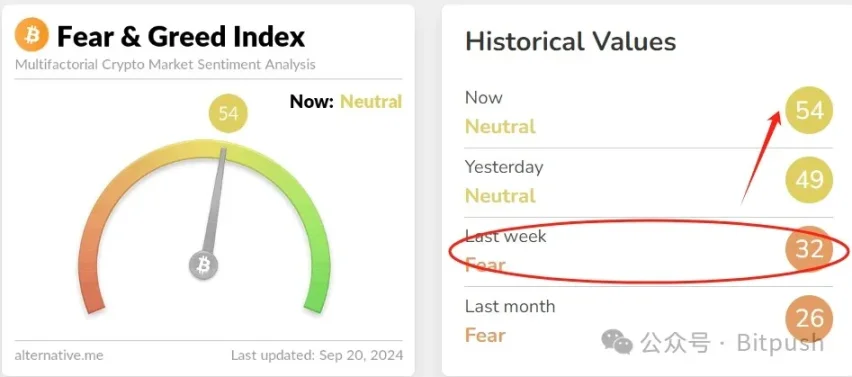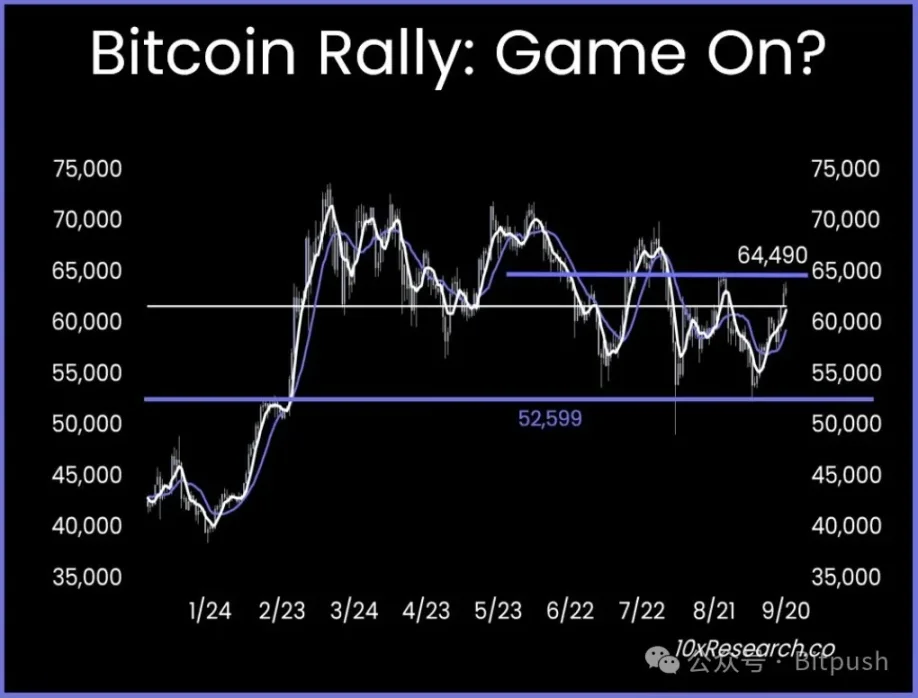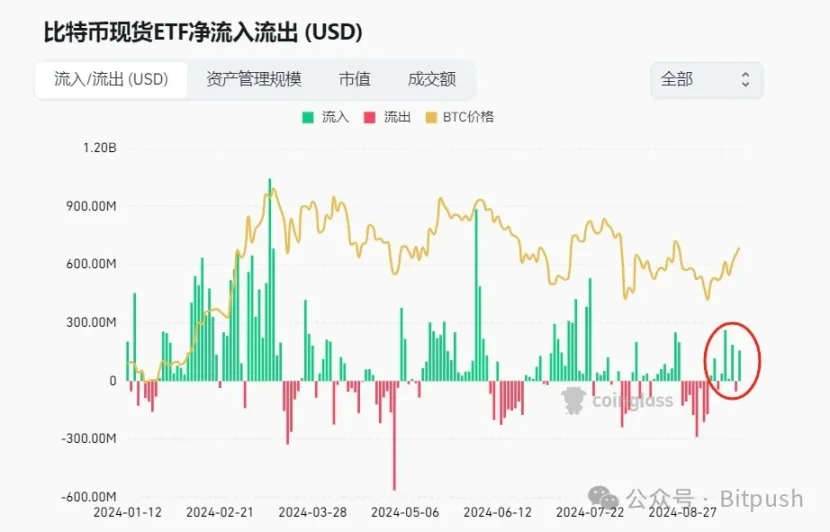This time, the main stimulus for the rise in Bitcoin is the 50 basis point rate cut by the Federal Reserve; but the deeper reason is that there have been some positive developments in the Bitcoin ecosystem, which in turn has led to a certain rebound in on-chain activity.
By: Asher Zhang
At 7:00 on September 11th, I published an article titled "Has the Crypto Bull Market Gone? So Far, BTC Has Not Disappointed Everyone Who Has Persisted." The article was written a few days before it was published, at a time when the market was in a pessimistic mood of panic selling. As of now, Bitcoin has indeed not disappointed everyone who has persisted. With the Federal Reserve's 50 basis point rate cut, both the macro market and the crypto market are undergoing significant changes. How will these new changes affect Bitcoin? What quiet changes are happening in the crypto market?
Bitcoin Breaks the Downtrend Line, Resistance Becomes Important Support
With the stimulus of the Federal Reserve's rate cut, Bitcoin has risen sharply recently. The panic index has risen sharply in the past few days, now exceeding 50, causing a shift in market sentiment.

From a technical analysis perspective, Bitcoin is currently clearly in a bearish trend. 10x Research, a crypto research institution, stated on the X platform that Bitcoin remains one of the most attractive assets in terms of risk/reward potential. Currently, a breakthrough of the Bitcoin downtrend line may indicate a stronger upward momentum, with the 21-week simple moving average ($60,996) being a key indicator to determine whether it is in a bull market (above) or a bear market (below). Breaking this level could set Bitcoin's target at $65,000 (which is now within reach). It is worth noting that the current trading signal has increased long positions to a net long position of 70% for the first time. According to historical pattern analysis, this change indicates that Bitcoin and Ethereum may provide attractive buying opportunities in the next 2-3 months.

Market Risk Appetite Rises After Rate Cut, Bitcoin Attracts Financial Market Attention
In the early hours of the 19th, the Federal Reserve announced a 50 basis point rate cut, lowering its overnight lending rate range from 5.25%-5.5% to 4.75%-5%, the first rate cut in four years. In the early hours of the 20th Beijing time, U.S. stocks closed higher on Thursday, with tech stocks leading the gains. The Dow rose more than 500 points, and the S&P 500 closed above 5700 points for the first time, both reaching historic highs. Bitcoin, which had previously followed a pattern of falling without rising, has performed exceptionally well this time.
The reason why both the macro market and the crypto market have performed well is related to the Federal Reserve's aggressive 50 basis point rate cut. Previously, the market generally expected the Federal Reserve to cut rates by 25 basis points, but the unexpected 50 basis point cut has surprised some investors. However, the market is generally accepting of this. Prior to the rate cut, the market was mainly concerned about two things: one was a recession in the U.S. economy, so the Federal Reserve had to cut rates significantly; the other was the strong U.S. economy, so the Federal Reserve was slow to cut rates, which meant that liquidity was still not very abundant. But now, with the strong U.S. economy and the Federal Reserve's aggressive easing, it is easy to stimulate market optimism, increase market risk appetite, and attract assets like Bitcoin. As a result, net inflows of funds into Bitcoin spot ETFs have recently continued to rise.

Regarding the 50 basis point rate cut by the Federal Reserve, Jeremy Siegel, a professor emeritus at the Wharton School of the University of Pennsylvania, said on Thursday, "This is the best news I've heard from the Federal Reserve in many years. This is great news for the market and for the economy."
As for why the Federal Reserve cut rates by 50 basis points? Federal Reserve Chairman Powell said after the FOMC meeting on Wednesday that, with the U.S. economy still strong, starting the central bank's policy reversal with a significant rate cut would help reduce the likelihood of an economic downturn. I don't think anyone should see this as a new rhythm. We are adjusting policy to a more neutral level as the economy develops, and we are moving at a pace we believe is appropriate.
Overall, the 50 basis point rate cut by the Federal Reserve has directly boosted market confidence in a soft landing for the U.S. economy and increased investor market preferences. This has turned the tide for assets like Bitcoin, which are now being sought after by the market, and funds have seen sustained net inflows. However, it is worth noting that the Federal Reserve's policy is more flexible and not a continuous rate cut. In the future, U.S. data will still have a significant impact on the crypto market.
The Federal Reserve's impact is significant, but what still affects Bitcoin is industry innovation
Bitcoin is essentially an emerging high-risk asset, unlike traditional financial risk assets. For example, few countries use risk assets as their national fiat currency, but Bitcoin, which is also a risk asset, is increasingly being used as fiat currency by some small countries. This is related to its decentralized, scarce, and other financial attributes. Therefore, the analysis of Bitcoin is not as simple as the analysis of financial assets. This has been a point that I have always insisted on: Bitcoin is a high-risk asset, but its driving force is still the technological innovation and application of blockchain. While Bitcoin may only be considered a risk asset in traditional financial markets, in the crypto industry or Web3, it is seen as digital gold. Therefore, with the continuous development of the blockchain industry, its underlying technological attributes will become more apparent.
Currently, some traditional financial institutions are gradually recognizing that Bitcoin's risk asset attributes are different from those of traditional risk assets. In a research report, BlackRock stated: Due to its high volatility, Bitcoin is clearly a high-risk asset. However, most of the risks and potential drivers of returns that Bitcoin faces are fundamentally different from those of traditional high-risk assets. As a scarce, non-sovereign, decentralized global asset, Bitcoin is seen as a safe haven choice by some investors during market panics and certain geopolitical turmoil events. In the long run, the adoption trajectory of Bitcoin may be driven by concerns about global currency stability, geopolitical stability, U.S. fiscal sustainability, and U.S. political stability, in contrast to the general relationship between traditional risk assets and these forces.
Overall, in addition to the impact of the Federal Reserve's rate cut, Bitcoin's recent rise is also closely related to the enhanced on-chain activity driven by ecosystem development.
Recently, Fractal Bitcoin has attracted a lot of attention in the market. Fractal Bitcoin, launched by the Unisat team, is also a Layer 2 solution for Bitcoin, claiming to be the "only native Bitcoin expansion solution" at present, with a focus on stronger compatibility with Bitcoin and shared security. Without changing the original Bitcoin code, it increases transaction speed and raises transaction confirmation time to 30 seconds, more than 20 times faster than the original Bitcoin mainnet, in contrast to at least 10 minutes.
In addition to Fractal Bitcoin, Stacks, the most well-known Layer 2 solution in the Bitcoin ecosystem, underwent the Nakamoto upgrade on August 28th. This upgrade is significant for Stacks for four main reasons: 1) Stacks' production reward per Bitcoin block was reduced from 1000 STX to 500 STX; 2) Stacks' block production was decoupled from Bitcoin's block time, reducing block confirmation time from over 10 minutes to 10 seconds, increasing TPS by more than 60 times; 3) The new consensus mechanism writes historical data of the Stacks chain into Bitcoin blocks, making it impossible to tamper with Stacks block data without changing Bitcoin block data; 4) Decentralized anchored coin sBTC was launched.
Summary
Overall, the main stimulus for the recent rise in Bitcoin is the Federal Reserve's 50 basis point rate cut; but the deeper reason is the emergence of some positive developments in the Bitcoin ecosystem, which in turn has led to a certain rebound in on-chain activity. I am optimistic about the future market, but the crypto industry urgently needs to address application innovation. In the current context of a lack of application innovation, Bitcoin's upward path still lacks certain intrinsic impetus. In addition, the path of the Federal Reserve's rate cut will still consider various economic data. Although the overall outlook is optimistic, caution should also be maintained.
免责声明:本文章仅代表作者个人观点,不代表本平台的立场和观点。本文章仅供信息分享,不构成对任何人的任何投资建议。用户与作者之间的任何争议,与本平台无关。如网页中刊载的文章或图片涉及侵权,请提供相关的权利证明和身份证明发送邮件到support@aicoin.com,本平台相关工作人员将会进行核查。




